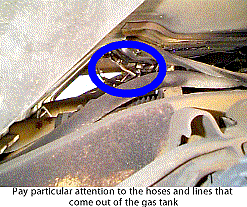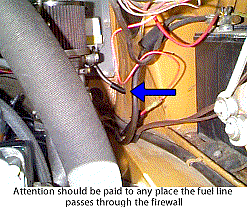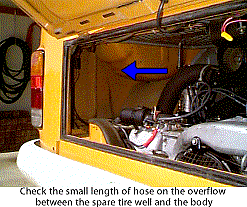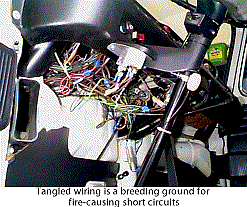Some Practical Advice on Preventing Charbroiled Busses
by Jerry Brown
As often as we hear stories about VWs burning,
or see them on the side of the road smoking, it sometimes seems a
wonder there are any Type 2s left on the road at all. It's truly
amazing how many ways there are for your beloved bus to catch on
fire. Without getting into the really obscure ones, I'll discuss
some ways you can prevent your bitchin' sano resto bus from turning
into a bitchin' sano resto hunk of charcoal. We'll look at three
areas--- fuel lines, carbs, and electrical stuff.
Fuel Lines
 You've only heard the warnings about a million
times folks. Check your fuel lines regularly. Before doing this I
usually run my fuel tank down toward empty, and I keep a couple of
golf tees and a bucket to catch any spillage. I also have my fire
extinguisher handy. Starting out from the bottom of the fuel tank
(see photo), check the rubber fuel hose for signs of deterioration
or stiffness. If in doubt, go get a couple of yards (meters for the
rest of the world) of appropriately sized fuel hose from your local
parts supplier, and just replace the stuff. It's cheap insurance. I
use fuel injection line because it's a little tougher stuff, meant
to handle more pressure. It costs only a little more. Go ahead and
put new hose clamps on there while you're at it.
You've only heard the warnings about a million
times folks. Check your fuel lines regularly. Before doing this I
usually run my fuel tank down toward empty, and I keep a couple of
golf tees and a bucket to catch any spillage. I also have my fire
extinguisher handy. Starting out from the bottom of the fuel tank
(see photo), check the rubber fuel hose for signs of deterioration
or stiffness. If in doubt, go get a couple of yards (meters for the
rest of the world) of appropriately sized fuel hose from your local
parts supplier, and just replace the stuff. It's cheap insurance. I
use fuel injection line because it's a little tougher stuff, meant
to handle more pressure. It costs only a little more. Go ahead and
put new hose clamps on there while you're at it.
Start working your way from the fuel tank past
the fuel pump towards the carbs, replacing line as you go. Check
all the metal sections for holes, crimps, wear, etc. Whereever the
line passes through a firewall or bulkhead, pay very close
attention (see photo). Bob Hoover has some great
advice for making a bulkhead fitting in one of his "sermons", but
any way that stops the fuel lines from rubbing against sharp metal
edges will work.
Bob Hoover has some great
advice for making a bulkhead fitting in one of his "sermons", but
any way that stops the fuel lines from rubbing against sharp metal
edges will work.
Check where your fuel line connects to your
carburetor, since this is a common source of leakage. Also check
your fuel filter connections for leakage. I personally don't like
my fuel filter to be in the engine room, so I have it mounted up in
my right rear fender well. It's easier to change, too. The fuel
filter is for a Nissan 300ZX, a big, fat metal canister that I have
mounted in a bracket so it doesn't flop around. I run a Facet
electric fuel pump, and it's mounted up there as well. If I do have
to pull the filter, the fuel spills harmlessly on the ground
instead of on the engine.
Another place to check that, judging from list
traffic and personal experience, rarely gets checked is the short
piece of hose on the tank overflow line between the spare tire well
and the body (see photo). Every one I've checked so far has been
really rotten, and this pup can cause you to burn. I found this
quite by accident on my '72, and it seems to affect all the late
model busses (loafs) on a full tank. This piece of hose is only
about 2.5 inches long. Just stick a new piece on, no clamps are
necessary, since there's really no pressure.

Carburetors
I once had a 71 Super Beetle with a Solex 34PICT3 carb on it, and
got a really rude surprise one day while working it. I had just put
on some new fuel line (following my own advice!), and while tucking
it away, the brass hose barb on the carb that the fuel line slides
onto came out! This is normally just pressed in there, but it can
come loose and spray fuel everywhere. Check yours to make sure it's
tight. If not, clean it thoroughly and use a thin coat of JB Weld
to keep it in. You can also use some small diameter wire, wrap two
or three times tightly around the fuel hose, then attach the other
end somewhere on the other side of the carb. This will prevent the
hose from popping off even if the barb is loose.
It also goes without saying that the carb itself should be checked
from time to time to make sure gaskets or fittings aren't leaking.
Not only will you be less likely to burn, but your engine will run
better. While you're there spray some carb cleaner on the
linkages.
Electrical Fires
 These can occur damn near anywhere, and most of
them are preventable. When I work on my bus, I check the wiring and
hoses in the vicinity of the area. Any frayed wires or bad
connections get replaced. It only takes one well placed spark at
the right time to ruin your day. Likely areas are the engine room
and under the dash. My dash is a tangled mess right now, and it's
on my project list to clean up (see photo). I also replaced my
stock VW fuses with the Buss-type fuses. Bob Hoover deserves credit
for turning me on to that idea as well, he has a sermon on that as
well. I'm no electrical genius, and I don't know how to use my
multimeter, but I can make a good electrical connection and I can
replace a piece of wire. So can you.
These can occur damn near anywhere, and most of
them are preventable. When I work on my bus, I check the wiring and
hoses in the vicinity of the area. Any frayed wires or bad
connections get replaced. It only takes one well placed spark at
the right time to ruin your day. Likely areas are the engine room
and under the dash. My dash is a tangled mess right now, and it's
on my project list to clean up (see photo). I also replaced my
stock VW fuses with the Buss-type fuses. Bob Hoover deserves credit
for turning me on to that idea as well, he has a sermon on that as
well. I'm no electrical genius, and I don't know how to use my
multimeter, but I can make a good electrical connection and I can
replace a piece of wire. So can you.
Last but not least, check your fire extinguisher
regularly. If you don't have one, get one or two, and keep them
handy! You can get them on sale pretty regularly. Be sure to get
the proper rating. No bus should be without one or two. One of mine
is behind my seat, the other is in the back. If you're feeling
really fancy, rig up a halon system for the engine room. Then tell
us all how you did it.
I'm sure there are about a million other small
things you can check or do to prevent a fire in your Type 2. I just
wanted to highlight a few ways to not burn. Enjoy!


 You've only heard the warnings about a million
times folks. Check your fuel lines regularly. Before doing this I
usually run my fuel tank down toward empty, and I keep a couple of
golf tees and a bucket to catch any spillage. I also have my fire
extinguisher handy. Starting out from the bottom of the fuel tank
(see photo), check the rubber fuel hose for signs of deterioration
or stiffness. If in doubt, go get a couple of yards (meters for the
rest of the world) of appropriately sized fuel hose from your local
parts supplier, and just replace the stuff. It's cheap insurance. I
use fuel injection line because it's a little tougher stuff, meant
to handle more pressure. It costs only a little more. Go ahead and
put new hose clamps on there while you're at it.
You've only heard the warnings about a million
times folks. Check your fuel lines regularly. Before doing this I
usually run my fuel tank down toward empty, and I keep a couple of
golf tees and a bucket to catch any spillage. I also have my fire
extinguisher handy. Starting out from the bottom of the fuel tank
(see photo), check the rubber fuel hose for signs of deterioration
or stiffness. If in doubt, go get a couple of yards (meters for the
rest of the world) of appropriately sized fuel hose from your local
parts supplier, and just replace the stuff. It's cheap insurance. I
use fuel injection line because it's a little tougher stuff, meant
to handle more pressure. It costs only a little more. Go ahead and
put new hose clamps on there while you're at it. Bob Hoover has some great
advice for making a bulkhead fitting in one of his "sermons", but
any way that stops the fuel lines from rubbing against sharp metal
edges will work.
Bob Hoover has some great
advice for making a bulkhead fitting in one of his "sermons", but
any way that stops the fuel lines from rubbing against sharp metal
edges will work.
 These can occur damn near anywhere, and most of
them are preventable. When I work on my bus, I check the wiring and
hoses in the vicinity of the area. Any frayed wires or bad
connections get replaced. It only takes one well placed spark at
the right time to ruin your day. Likely areas are the engine room
and under the dash. My dash is a tangled mess right now, and it's
on my project list to clean up (see photo). I also replaced my
stock VW fuses with the Buss-type fuses. Bob Hoover deserves credit
for turning me on to that idea as well, he has a sermon on that as
well. I'm no electrical genius, and I don't know how to use my
multimeter, but I can make a good electrical connection and I can
replace a piece of wire. So can you.
These can occur damn near anywhere, and most of
them are preventable. When I work on my bus, I check the wiring and
hoses in the vicinity of the area. Any frayed wires or bad
connections get replaced. It only takes one well placed spark at
the right time to ruin your day. Likely areas are the engine room
and under the dash. My dash is a tangled mess right now, and it's
on my project list to clean up (see photo). I also replaced my
stock VW fuses with the Buss-type fuses. Bob Hoover deserves credit
for turning me on to that idea as well, he has a sermon on that as
well. I'm no electrical genius, and I don't know how to use my
multimeter, but I can make a good electrical connection and I can
replace a piece of wire. So can you.
